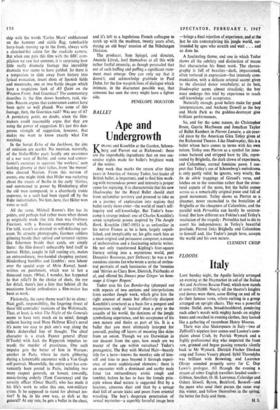Ape and Undergrowth
BALLET .IPLING and Koechlin at the Garden, Schoen- berg and Pierrot out at Richmond: these are the improbable ingredients that on two suc- cessive nights made for ballet's brightest week of the winter.
Any week that marks the return after thirty years in America of Antony Tudor, lost leader of British ballet, is important, and to find him work- ing with tremendous power and intensity is proper cause for rejoicing. It is characteristic that his new Shadowplay for the Royal Ballet should start from unfamiliar territory and proceed to take us on a journey of exploration into regions that ballet rarely dares enter—the world of man's self- inquiry and self-knowledge. But Tudor's base- camp is strange indeed: one of Charles Koechlin's seven symphonic poems inspired by The Jungle Book. Koechlin (1867-1951) is as unfamiliar in his native France as he is here, largely unpub- lished, and inexplicably so; his gifts mark him as a most original and persuasive composer, a master of orchestration and a fascinating eclectic writer. He not only transformed Kipling's four-square literary setting into a mysterious world, part Douanier Rousseau, part Debussy; he was a tre- mendous cinema fan who wrote a series of orches- tral portraits of such luminaries of the 'twenties and 'thirties as Clara Bow, Dietrich, Fairbanks et al, and offered his Danses pour Ginger 'en horn- mage a Ginger Rogers.'
Tudor uses his Les Bandar-log (plumped out with repeats of two sections and interpolations from another Jungle work, which give him the right amount of music but effectively dissipate Koechlin's structure) as a basis for a pungent and mysterious study of 'natural' man a prey to the assaults of his world, the denizens of the jungle symbolising experience, and his acceptance of his own nature and theirs as part of his. It is a ballet that you must ultimately interpret for yourself, peeling off layers of meaning like skins from an onion. Though we are Darwinian in our descent from the apes, how much are we master of the ape within ourselves? Tudor's protagonist, The Boy with Matted Hair—beastly title for a hero—knows the monkey side of him- self and tries to pass beyond it through experi- ence of more sophisticated elements : there is an encounter with a dominant and earthy male force (an extraordinary erotic rough and tumble), before he has to face the female prin- ciple whose dual nature is suggested first by a luscious, amorous duet and then by a savage duel full of savage kicks and poses from oriental wrestling. The boy's desperate penetration of sexual mysteries—a superbly forceful image here —brings a final rejection of experience, and at the last he sits contemplating his jungle world, sur- itunded by apes who scratch and wait . . . and so does he.
A fascinating theme, and one in which Tudor shows all the subtlety and distinction of means that characterise his finest work. The choreo- graphy is full of beauties—dark, impassioned, often tortured in expression—but intensely com- municative, with a delicate oriental accent given to the classical dance vocabulary; at its best, Shadowplay seems almost ritualistic; the boy must undergo this trial by experience to reach self-knowledge and acceptance.
Naturally enough, good ballets make for good interpretations, and Anthony Dowell as the boy and Merle Park as the goddess-destroyer give brilliant performances.
So, and for the same reason, do Christopher Bruce, Gayrie MacSween and Jonathan Taylor of Ballet Rambert in Pierrot Lunaire, a six-year- old piece by the American Glen Tetley given at the Richmond Theatre. Like Shadowplay, this is a ballet whose hero comes to terms with his own nature. Tetley uses Pierrot as a symbol for inno- cence battered and stripped bare by life, repre- sented by Brighella, the dark clown of experience, and Columbine, eternal feminine pawn. I sus- . pect that Tetley's use of Schoenberg's melodrama is only partly valid; he ignores, very wisely, the fin de siècle trappings of Giraud's verse, and latches on to the sonorities rather than the struc- tural aspects of the score, but the ballet comes across as a remarkably original piece and full of good movement. Tetley shows us Pierrot as al- dreamer, never reconciled to the brutalities of Brighella or the cheapness of Columbine, and the parallel with Petrushka can hardly be uninten- tional. But how different are Fokine's and Tetley's resolution of the tragedy : Petrushka had to die to assert his independence; in Tetley's beautiful postlude, Pierrot links Brighella and Columbine to himself and, like Tudor's jungle hero, accepts the world and his own nature.
CLEMENT CRISP






























 Previous page
Previous page